N.Y. mayor’s race front-runner cast as a ‘socialist redistributionist’Posted in Articles, Media Archive, Politics/Public Policy, United States on 2013-09-06 04:00Z by Steven |
N.Y. mayor’s race front-runner cast as a ‘socialist redistributionist’
The Christian Science Monitor
2013-09-04
Harry Bruinius, Staff writer
Democrat Bill de Blasio, the most liberal major candidate in the New York City mayor’s race, is leading polls ahead of the Sept. 10 primary. Republicans sense an opportunity.
The surprising ascendancy of New York City Public Advocate Bill de Blasio may have energized the liberal wing of city Democrats, but the commanding mayoral front-runner has some Republicans cheering as well.
Despite the fact that the Republican line has won the mayor’s office five consecutive times in New York, conventional wisdom has long had the Democratic nominee easily winning the Nov. 5 general election this year.
It is still a city in which registered Democrats outnumber Republicans 6 to 1, after all, and which gave Obama 81 percent of its votes in 2012. Even the Democrat-turned-Republican-turned-Independent Mayor Michael Bloomberg, who won three terms on the Republican line, has deftly played down standard partisan divisions during his 12-year tenure.
But Mr. de Blasio has stunned the more moderate Democratic candidates the past few weeks with his relentless critique of the Bloomberg administration, as well as his dogged liberal message of income inequality in the shadow of Wall Street wealth. He also was very effective showcasing his interracial family – including his teenage son, Dante, whose Afro-style hair and descriptions of his father in campaign commercials have become some of the most memorable of the race…
…But even de Blasio’s multicultural and nontraditional family could cause some problems in the general election – even in a city like New York. His wife, Chirlane McCray, was a high-profile lesbian activist who wrote a groundbreaking article for Essence magazine in 1979, describing her coming out as a gay black woman.
According to GOP consultant Johnson, who says he is familiar with some of the internal polling of the Lhota campaign, there are a number of groups, including many Jewish voters, who remain uncomfortable with de Blasio.
“Despite all the popularity, despite everything we’ve heard about his son stealing the show, they’re also seeing, too, that there is still some backlash about the mixed marriage,” he says…
Read the entire article here.

